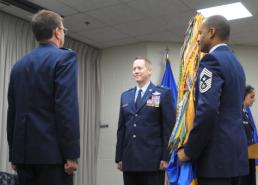Story by: 2nd Lt. Phil Fountain
Posted On: January 28, 2016
 2nd Lt. Phil Fountain
2nd Lt. Phil Fountain
Brig. Gen. David M. McMinn (center), chief of staff of the Texas Air National Guard, prepares to receive the organization’s flag in a ceremony recognizing the change of command from Maj. Gen. Kenneth W. Wisian (left) to McMinn during a ceremony at Camp Mabry, in Austin, Texas, Jan. 23, 2016. Command Chief Master Sgt. Marlon Nation, the command chief master sergeant of the Texas Air National Guard, holds the flag prior to the change of command ceremony. (U.S. Air National Guard photo by 2nd Lt. Phil Fountain / Released)
AUSTIN, Texas – Members of the Texas Air National Guard gathered to welcome their new commander and salute their outgoing commander at Camp Mabry, in Austin, Texas, Jan. 23, 2016.
Maj. Gen. Kenneth W. Wisian ceremoniously relinquished command of the Texas Air National Guard to Brig. Gen. David M. McMinn, the organization’s chief of staff, immediately prior to his retirement.
“It’s a great time for Texas,” said Maj. Gen. John F. Nichols, the Adjutant General of Texas, who officiated the ceremonies. “We don’t need a change, but it’s a great thing to have a change and bring a new perspective in.”
McMinn brings three decades of experience to the role, according to his biography. He is a command pilot with more than 5,000 flight hours in numerous aircraft, including the C-130 Hercules assigned to the Texas Air National Guard’s 136th Airlift Wing, in Fort Worth.
“I charge you (McMinn) with taking care of the organization, taking care of those who serve Texas and the nation, as I do with everyone who’s in a command position,” Nichols said. “Ken did it honorably.”
“We never failed Texas and we didn’t fail the nation in any of the missions we did,” Nichols said. “I charge you to continue that.”
McMinn was humbled to receive the appointment.
“Thank you, General Nichols,” McMinn said. “Thank you for the trust you put in me to take over this position, especially from him. Big shoes (to fill).”
In addition to the 136th Airlift Wing, the Texas Air National Guard’s largest operational units include the 147th Reconnaissance Wing, in Houston, and the 149th Fighter Wing, in San Antonio.
Moreover, the organization is made up of more than 3,200 airmen who operate and manage facilities and equipment valued in excess of $500 million to support state and federal missions.
The Texas ANG leadership transition began when Wisian announced his plan to retire from the military and join the staff of the Texas General Land Office, a Texas state agency, as a senior deputy director overseeing coastal protection and disaster recovery operations.
“I’ve known Dave a long, long time,” Wisian said. “I’m excited to pass the flag on to him. We’ve both came to the guard within about a year of each other, back in the ‘90s.”
“Dave’s the right person to take the helm now,” Wisian said. “I know you all will have fantastic future working with him, and I’m looking forward to it.”
Nichols and Wisian both discussed some the challenges McMinn will face as commander.
“We have a lot of challenges, with sequestration, as it is, and we have challenges with modernization,” Nichols said. “And we have challenges with force structure, having more missions than we have people to do it.”
But they expressed confidence in the future of the organization.
“It looks like there’s a significant corner turned,” Wisian said. “There’s good prospects now for some updated hardware, the Air Guard is being recognized by the Air Force – not nearly as well as it should be – but better than it has for a long time. Things are on an upward vector now.”
Wisian’s retirement caps off a 34-year career he began as a cadet in the Air Force Reserve Officer Training Corps program at the University of Texas at Austin.
Wisian served in the active duty Air Force for ten years before transitioning to the Texas Air National Guard, where he held leadership positions at all levels, including combat service in the Balkans, Afghanistan and Iraq.
In addition to serving as a traditional Air National Guardsman, McMinn maintains a civilian career as a commercial airline pilot. He has deployed in support of Operations Enduring Freedom and Iraqi Freedom, where he commanded at the group level.
“It’s a big trust, and I don’t take that lightly,” McMinn said of his assignment. “I look forward to providing as much of me as I possibly can for Texas.”
“From the time I joined the Texas Air National Guard, in 1992,” McMinn said, “from that moment, I always felt I owed the Texas Air Guard more than it could ever owe me. I still feel that today. I’m as charged up and excited about doing great things for the people of Texas, and for the people within the National Guard of Texas than I ever have been.”
As the new commander, McMinn said his plan is to ensure the focus of the headquarters staff remains oriented toward serving the needs of the air wings.
“I’m excited about being your commander, excited about being value-added, and am excited that our staff here serves the wings,” McMinn said. “We’re going to take care of you guys (at the wings), that’s our job.”
McMinn also looked to the future.
“We’re going to do good things, and we’re going to grow and prosper and learn from each other,” McMinn said.
“We’re all going to leave this position, whether through retirement or promotion, or just move on to your next assignment,” he said. “Hopefully, we’ll all be better airmen and better people for having served in the state headquarters. That’s my goal.”